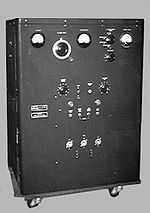BC-610
The BC-610 was a radio transmitter used by the U.S. Army Signal Corps during World War II.

History
In the early 1940s, the U.S. military sought a high-powered radio transmitter capable of infallible voice communications over 100 miles (160 km), sturdy enough to work in all conditions, flexible enough to be able to cover a wide range of frequencies, self-powered and able to operate in motion or at fixed locations. The Hallicrafters HT-4 transmitter was chosen from units available from various U.S. radio manufacturers. The HT-4 was designed for amateur radio use and had been commercially available for several years at a price of approximately $700, rivaling the cost of a car. It was considered compact and stable for its era and could deliver 325 watts of power for voice communications and 450 watts during Morse code operation. It was quartz crystal controlled, but could be used over a wide range of frequencies through use of the master-oscillator power amplifier.
Modifications requested by the Signal Corps' were performed by Hallicrafters' engineers working with U.S. Army technicians at Fort Monmouth. They made a new version of the HT-4, which was known as the BC-610 transmitter, a part of the SCR-299 mobile communications unit, and production began in 1942. General Dwight Eisenhower credited the SCR-299 in the reorganization of U.S. forces, which led to their victory against the Nazis at Kasserine Pass. The SCR-299 was also used in the Invasion of Sicily and later, Italy.[1] Over 25,000 units were produced by Hallicrafters and other allied companies. In 1944, a short subject film was produced by the Jam Handy Organization and sponsored by the Hallicrafters Company detailing how the HT-4 transmitter was adapted for military service and dramatizing its use by the U.S. military during World War II.[2][3]
Specifications
- Frequency coverage: 1.5 to 18 MHz
- Mode: AM, CW
- RF power Output: 400 watts
- Vacuum tubes: Eimac 250TH final
- Operating frequency determined by plug-in tuning units and final coils (up to three at once) in addition to FT-171B crystals
- Signal Corps Radio sets: SCR-299, SCR-399, SCR-499, or GRC-38, AM requires BC-614 (or Hallicrafters HT-5) speech amplifier
- Weight: 390 lb (177 kg) (without BC-614)
- Manual: TM 11-280 [4][5]
The "A" through "I" models are the same basic unit with relatively minor component and cosmetic differences.[6]
See also
- ARC-5
- BC-348
- BC-654
- R-390A
- SCR-299
- Signal Corps Radio
- Vintage amateur radio
References
- ↑ http://web.archive.org/web/20100105221519/http://www.gordon.army.mil/ocos/ac/WWII/SCR299.asp The SCR-299, United States Army Signal Center, Fort Gordon, GA
- ↑ https://archive.org/details/VoiceofV1944 Hallicrafters, The Voice Of Victory (1944), Internet Archive
- ↑ https://archive.org/details/VoiceofV1944_2 Hallicrafters, The Voice Of Victory (1944), Internet Archive, Part 2
- ↑ http://hereford.ampr.org/millist/m13.html ampr.org
- ↑ TM-11-826, Radio Transmitters BC-610-E,-F,-G,-H,-I, US Government Printing Office
- ↑ http://www.radiomuseum.org/r/hallicraft_ht_4_ht4.html Radio Museum